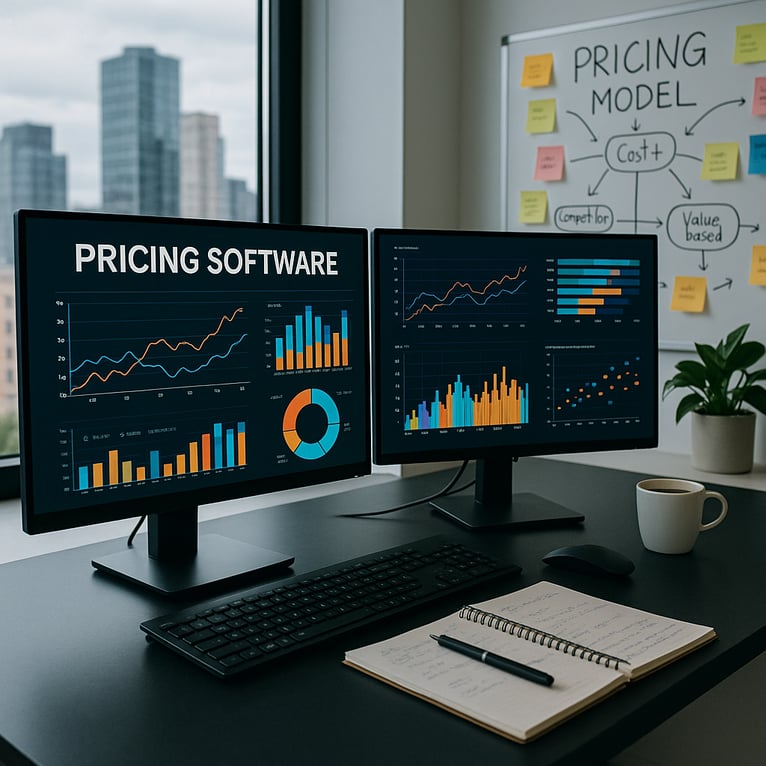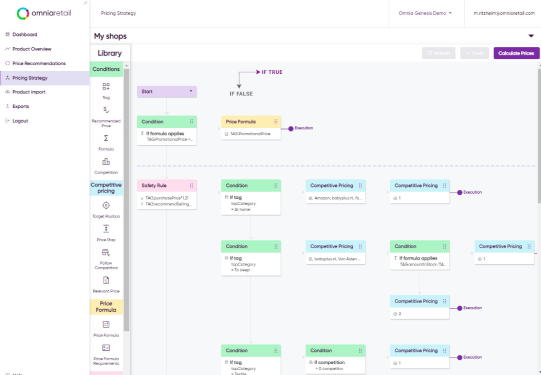As we pointed out in our last research post on Black Friday pricing data analysis, the Direct-to-Consumer (DTC) market has fundamentally transformed. What was once considered a niche strategy has become the primary sales channel for many brands. But with the growth of the DTC segment comes increased competitive pressure, especially during peak periods like Black Friday. The critical question is: How do you maintain oversight of your competitors while making data-driven pricing decisions in real-time?
With advanced tools like Omnia pricing software, DTC brands can automate price monitoring and market analysis, apply sophisticated competitive pricing strategies, and react to real-time changes across multiple markets. This combination of insight and execution ensures your pricing strategies deliver maximum impact in an increasingly competitive landscape.
Black Friday: The Stress Test for Your Pricing Strategy
Black Friday and the subsequent Cyber Week are both blessings and curses for DTC brands. On one hand, they offer enormous revenue opportunities; on the other, they bring ruthless price competition. Add to this regulatory requirements like the EU Omnibus Directive, which mandates that any advertised discount must reference the lowest price from the previous 30 days.
This is where the value of modern competitive pricing software becomes particularly evident. Leading solutions now offer automated compliance checks that ensure your promotional prices meet legal requirements.
Compliance-ready pricing for Black Friday with Omnia
One of our newer features specifically addresses EU Omnibus Directive compliance:
- Min Selling Price Last 30 Days: Automatically displays the lowest selling price for each product over the past 30 days, ensuring your discount claims are legally compliant.
- Number of Days Imported Last 30 Days: Shows how many days of pricing data Omnia successfully received, helping you determine if there's enough historical data to confidently use the minimum price in compliance checks.
These capabilities enable you to automate compliance verification, evaluate promotion eligibility efficiently, and display reference prices dynamically on product pages or in marketing campaigns, all without manual verification that consumes valuable time during the busiest selling period of the year.
McKinsey's research on promotional effectiveness shows that retailers who leverage data-driven approaches to promotional planning can increase their promotional ROI by up to 30%. The key lies in understanding not just what discounts to offer, but when to offer them and how they compare to competitive market dynamics.
Black Friday Pricing Preparation: What Last Year’s Data Reveals
An analysis of six weeks of pricing data across 60,000 products in Germany and the Netherlands shows that prices start dropping one to two weeks before Black Friday, with recovery only after Cyber Monday. Retailers who plan early capture more visibility and momentum.
Category patterns vary: electronics see gradual early declines, health & beauty remains cautious until just before the event, and sporting goods often feature two discount waves. Lower-priced items drive the biggest perceived savings, with discounts most frequent in the €0–50 range.
Competitive pressure shapes discount depth: popular products get smaller cuts to avoid price wars, while niche items can be discounted more aggressively.
In short, early preparation, category-specific insights, and awareness of competitive dynamics are key to turning Black Friday discounts into profitable opportunities.
As agentic commerce scales, promotional windows may become even more dynamic. AI agents could trigger purchasing decisions the moment your price drops below a certain threshold, making real-time pricing adjustments and instant market analysis essential capabilities for competing effectively.
Why DTC Brands Need a Different Competitive Pricing Strategy
Direct-to-Consumer brands face unique challenges. Unlike traditional retailers, they control their entire value chain, but must simultaneously compete against established marketplaces, resellers, and other DTC competitors. Price transparency in e-commerce means one thing: your customers are constantly comparing.
And the landscape is shifting even more dramatically. McKinsey predicts that we're entering an era of "agentic commerce," where AI agents will increasingly make purchasing decisions on behalf of consumers. These agents will compare prices, evaluate value propositions, and execute transactions with unprecedented speed and efficiency. For DTC brands, this means competitive pricing is no longer just about appealing to human shoppers; it's about being discoverable and competitive in an AI-driven marketplace where price comparisons happen in milliseconds.
An effective competitive pricing strategy for DTC brands must consider multiple dimensions. You need to know not only what your direct competitors are charging, but also understand how your products are priced across different channels. This is precisely where professional competitive pricing software comes into play.
Improving your DTC Strategy? Read our Extensive Guide

According to McKinsey research, companies that excel at pricing can generate returns that are 200-350% higher than their competitors. Yet many organizations still struggle with the basics of competitive pricing, lacking the real-time market data and analytical capabilities needed to optimize their pricing strategies effectively.
Market Data as the Foundation of Intelligent Pricing Decisions
Market analysis begins with data, but not just any data. You need precise, current market data that provides a complete picture of your competitive landscape. Modern pricing software captures not only prices, but also availability, shipping costs, and product variants from your competitors.
What makes the difference? The ability to transform this data into actionable insights. Imagine being able to see at a glance which competitor most frequently offers the lowest prices across your entire assortment. Or identifying new market entrants before they capture significant market share.
Omnia Retail's newest capabilities in competitive intelligence
Recent developments in competitive pricing software enable exactly this kind of transparency. New report fields now allow you to:
- Identify the cheapest competitors: Automatically see which shops carry the cheapest offers across your assortment, with or without shipping costs included. This helps you quantify how often specific competitors undercut you and decide which competitors are most relevant for your pricing strategy.
- Spot new competitive threats: Identify emerging competitors that threaten significant parts of your assortment before they capture market share.
- Export insights to your workflow: Schedule and share competitive intelligence reports, or connect them to your BI dashboards for custom analyses.
In the emerging world of agentic commerce, this kind of granular market intelligence becomes even more critical. AI shopping agents will optimize not just for price, but for total cost of ownership, including shipping, taxes, and delivery times. Your competitive pricing strategy must account for all these variables to remain competitive when algorithms, rather than humans, are making purchasing decisions.
From Data to Decisions: The Power of Context
The sheer volume of market data can be overwhelming. What matters is not just which data you collect, but how you filter and interpret it. Modern platforms enable you to focus your market analysis on truly relevant competitors.
Want to know how your prices compare to premium competitors? Or are you primarily interested in the discount segment? Through intelligent filtering options, you can precisely align your competitive pricing strategy with your positioning.
Enhanced product overview capabilities
Recent platform enhancements make contextual analysis more powerful than ever:
- Competitor filters: Tailor your analysis by selecting only the competitors most relevant to your business. All core metrics, average price, price ratio, and cheapest competitor price are calculated with your selected competitor context in mind.
- Units sold visibility: See which products sold the most units in the last four weeks and how their prices compare to the market. This helps you focus attention on items that matter most to your business.
- Time machine for market insights: View competitive data for any day within the past 30 days, helping you track changes, spot trends, and refine pricing strategies with historical context.
- Unmatched product transparency: Identify products that couldn't be matched with market data directly from your dashboard, allowing faster action to improve data coverage.
Preparing for an Agent-First Future
McKinsey's research on agentic commerce suggests that AI agents could influence up to 40% of e-commerce transactions within the next few years. This shift has profound implications for competitive pricing strategy. When AI agents shop on behalf of consumers, they'll leverage comprehensive market data to find optimal deals across multiple variables simultaneously.

This means your competitive pricing software needs to do more than track competitor prices; it needs to help you understand your position in the total value equation. Are your shipping costs competitive? How quickly can you fulfill orders compared to competitors? What's your stock availability? These factors, when combined with price data, create a complete picture of your competitive position in an agent-driven marketplace.
The brands that will thrive in this new era are those investing now in sophisticated market analysis capabilities that can process multiple data streams and provide actionable intelligence in real-time.
Enterprise Perspective: Pricing Across Markets and Channels
For growing DTC brands expanding internationally, complexity increases exponentially. Different markets, currencies, competitors, and regulatory requirements demand a pricing infrastructure that enables scalability. Especially during peak periods like Black Friday, when competitive pressure and price volatility reach their highest point.
The latest generation of competitive pricing software addresses exactly this challenge. The new Organization Overview Dashboard, the first cross-portal feature designed for enterprise and mid-market customers, provides:
- One view across all portals: See key metrics such as total number of portals, products, offers, and price recommendations in a single dashboard.
- Trend tracking: Monitor offer history and price recommendation history over time, helping you spot anomalies or changes at a glance.
- Portal-level details: Drill down into each portal's activity, including match rates, dynamic pricing rates, and import/monitoring/calculation statuses.
- Flexible filters: Filter on specific portals by name, go back up to 30 days in time, and switch between daily or weekly views to better fit your analysis needs.
McKinsey emphasizes that successful pricing transformations require not just technology, but also organizational alignment and the right analytical capabilities. Companies that invest in comprehensive pricing infrastructure, including competitive intelligence tools, dynamic pricing engines, and cross-functional pricing teams, consistently outperform their peers.
Commercial Performance in Focus: Which Products Deserve Your Attention?
An effective competitive pricing strategy is not a one-size-fits-all solution. Not every product in your portfolio deserves equal attention. The art lies in focusing your resources on the products that have the greatest impact on your business.
Modern market analysis tools, therefore, integrate sales data directly into your competitive analysis. When you can see which products have sold the most units in the last four weeks and how their prices compare to the market, you can make informed decisions. Perhaps you'll discover that some of your top sellers perform well despite higher prices, a sign of pricing power. Or you identify products with low sales figures where aggressive competitor pricing might be the cause.
This integration of commercial performance data with competitive intelligence transforms pricing from a reactive exercise into a strategic capability that drives business results.
The Evolution of Competitive Pricing Software
The evolution of competitive pricing software goes far beyond simple price monitoring. It's about transparency, compliance, commercial intelligence, and the ability to react to market changes in real-time. For DTC brands looking to succeed in an increasingly competitive environment, access to precise market data and the ability to translate it into strategic decisions is no longer a nice-to-have; it's business-critical.
Black Friday may be the ultimate test, but the principles remain the same throughout the year: understand your market, know your position, and make pricing decisions based on facts rather than assumptions. With the right competitive pricing strategy and the proper tools, reactive pricing transforms into proactive market leadership.
Stay Ahead with Real-Time Market Intelligence
The difference between average and exceptional DTC brands often lies in the quality of their decision-making foundations. While some still rely on gut feeling and manual competitive analysis, pioneers have long been using automated market analysis to act faster, more precisely, and more profitably.
The competitive landscape is evolving rapidly, and the tools that help you navigate it are evolving just as fast. Features that bring competitor context directly into your dashboards, compliance automation that protects you from costly mistakes, and cross-market visibility that scales with your ambitions. These aren't future possibilities, they're current realities that forward-thinking brands are already leveraging.
As we move toward an agent-first commerce environment, the importance of sophisticated competitive pricing software will only intensify. The brands that invest now in building robust market analysis capabilities will be the ones best positioned to compete when AI agents become mainstream shopping assistants.
Conclusion
Success in the DTC space increasingly depends on your ability to turn market data into a competitive advantage. Whether you're preparing for Black Friday, planning your next market expansion, or positioning yourself for the agentic commerce revolution, the foundation remains the same: comprehensive market analysis powered by intelligent competitive pricing software.
The question isn't whether you need better market insights; it's whether you can afford to make pricing decisions without them. In a world where algorithms compare prices in milliseconds and consumers have AI agents optimizing their purchases, manual competitive analysis isn't just inefficient, it's a competitive disadvantage you can't afford.
Ready to elevate your competitive pricing strategy? Discover how Omnia pricing software can help you master market analysis, automate competitive intelligence, and stay ahead with real-time pricing strategies.
Frequently asked questions
What is competitive pricing software?
Competitive pricing software is a tool that automatically monitors competitor prices, analyzes market data, and provides insights to help businesses optimize their pricing strategies. Modern solutions like Omnia combine price monitoring with advanced market analysis, compliance automation, and dynamic pricing capabilities.
How can market analysis improve my competitive pricing strategy?
Market analysis provides the data foundation for informed pricing decisions. By tracking competitor prices, identifying market trends, and understanding your competitive position, you can optimize pricing to maximize revenue and margin while remaining competitive. Advanced market analysis tools also help you identify which competitors matter most and spot emerging threats early.
Why is competitive pricing especially important for DTC brands?
DTC brands face unique competitive pressures from marketplaces, resellers, and other direct competitors. Unlike traditional retailers, they must optimize pricing across multiple channels while maintaining brand positioning. With the rise of agentic commerce and AI shopping agents, having sophisticated competitive pricing capabilities is becoming essential for DTC success.
How does competitive pricing software help with Black Friday preparation?
Competitive pricing software enables data-driven Black Friday strategies by providing historical market data, automated compliance checks (such as EU Omnibus Directive requirements), real-time competitor monitoring, and the ability to test and implement promotional pricing strategies in advance. This ensures you can compete effectively during peak sales periods while maintaining margins and regulatory compliance.



.png?height=766&name=Untitled%20design%20(21).png)

